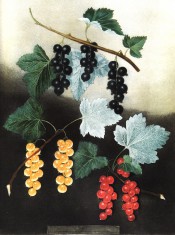Ribes rubrum L.
‘Spiny deciduous shrub with alternate, lobed leaves and racemes of small flowers in spring, followed by small, edible red or white fruits. To. 1.5m. [RHSD, Hortus].
Ribes sativum Syme is often said to be the parent of red and white currants, but others regard R. sativum as a variety of R. rubrum. The RHS Dictionary states: ‘These [R. rubrum and R. sativum] are the two main species that include all the red and white currants, but other species have been used in breeding modern cultivars, including R. petraeum, R. vulgare and R. multiforum. All are native to Europe although R. rubrum and R. petraeum are also found in Asia.’ [RHSD/1999].
Horticultural & Botanical History
Fuller gives a brief overview of the history of cultivated currants. ‘The species of the Currant, from which our cultivated varieties originated, are probably native of Northern Europe, as we do not find them mentioned by any of the old Greek or Roman writers, who were generally so particular to name every fruit known in their day. The English name Currant, or Corrans, as they were formerly called, was given them, because of their resemblance to the little Zante Grape, which is called Corinths in the English markets, as it was formerly almost entirely imported from Corinth.
The Black, Red and White Currant, although known to the inhabitants of Northern Europe for centuries, attracted very little attention until within the past hundred years. Turner, in 1557, does not name them in his list of cultivated fruits. Gerarde, in 1597, calls the Currant a smooth-stemmed Gooseberry. The Black Currant was formerly known as the Squinancy berry, because it was used to cure the quinsie. The people of Siberia use the leaves of the Black Currant for making a drink, the same as we use tea. Loudon says that the leaves, when dried, are an excellent substitute for green tea, and that few persons can detect the difference. The Red, White and Black Currants, one variety of each, were the only kinds known in cultivation until the beginning of the present century. Since that time considerable improvement has been made, and numerous varieties introduced.’ [Fuller – Small Fruit Culturist p.187/1867].
E. L. Sturtevant provides a much more detailed review of the history of the currant up to the development of arguably the first ‘modern’ currant, the old ‘Red Dutch’. ‘By the herbalists and early writers on horticulture, the first mention of the currant that I find, is by Ruellius in 1536, a French author, who praises it as a border plant, and its fruit as an appetizer. In 1539, Ammonius says “we cherish it in our gardens,” but adds nothing of further interest in this connection. Fuchsius in 1542 gives a figure which may be called a poor specimen of the Common Red, and which resembles certain seedlings which are now frequently obtained. He notes its occurrence in gardens passim. Tragus, who wrote in Germany in 1552, gives a figure of the garden currant, which may well be the Common Red. In 1558, Matthiolus refers to it as common in gardens, and it is also spoken of by Mizaldus in 1560. Pinaeus, 1561, gives a figure which may be that of a Common Red, while Lobel in 1576 and 1591 offers figures which are to be called Common Red, but which are of a far better appearance than those heretofore figured, and mentions also a sweet kind. Lytes translation of Dodoeus, edition of 1586, speaks of the currant in England, but translates one name as ‘beyond the sea’ gooseberry. This same year 1586, Camerarius figures the Common Red, as does Dalechamp in 1587. The next year, Camerarius gives directions for sowing the seed of the wild plant in gardens, and says these seedlings quickly come to fruit. We have hence the first clue as to how new varieties might originate, if this recommendation was generally followed. Camerarius also refers to a larger fruited currant than common, that was growing in the gardens of the Archduke of Austria, and this is the first indication I can note of improvement in varieties, such as might well be anticipated from the practice of growing seedlings. This ‘Ribes baccis riibris majoribus’ may perhaps be considered as the Red Dutch variety, or at least its prototype. In 1597, Gerarde, as before stated, scarcely recognized the currant as being in general culture in England, but the next year, or 1598, brings us to what may well be called a picture of the Red Dutch variety, given in Bauhin’s edition of Matthiolus, as also a mention of a white fruited variety, and another described as ‘sweet.’’ [Hedrick - The Small Fruits of North America p.317/1925].
Currants are figured in Pomona Britannica [PB pl.5/1812] and show the Black Currant, White Currant and the Dutch Red Currant, the latter possibly the first improved garden form. This is the illustration used here. The Red Currant is also figured in English Botany [English Botany pl.DXX/ 1863-1886].
History at Camden Park
Only four currants are listed in the Camden Park catalogues, and these not until 1857. All are probably red currants, although the identification of two of them is somewhat uncertain.
Notes
Published Jun 07, 2010 - 04:35 PM | Last updated Jun 07, 2010 - 05:00 PM
| Family | Grossulariaceae |
|---|---|
| Category | |
| Region of origin | Northern Europe to Asia |
| Synonyms |
|
| Common Name | Red Currant, White Currant |
| Name in the Camden Park Record | Currant |
| Confidence level | high |


